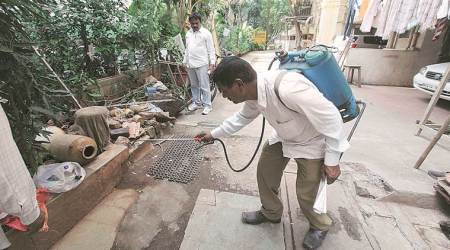 Source: Google Map
Source: Google Map
CHANDIGARH RECORDED a rise in dengue and leprosy in 2016, while the rate of C-Section deliveries, too, is quite high. These are among the findings listed in the National Health Mission’s 10th Common Review Mission (CRM). The CRM report has listed the positives of the Chandigarh health system as well as the challenges faced by the UT health department. The 10th Common Review Mission (CRM) under National Health Mission was held last November in 16 states/UTs, including Chandigarh. The CRM teams conducted extensive field visits followed by detailed state-level debriefings.
The report has praised the UT’s listing of severe anaemic women with a good follow-up mechanism. “Cleanliness at all delivery points was observed. SNCU is well maintained at Sector 16 GSMH. Awareness regarding Weekly Iron Folic Acid Supplementation (WIFS) programme is good in schools. Immunisation services are implemented well in the UT, which has a well-established dengue surveillance system in place, too. Currently, four hospitals have been identified in the city as sentinel hospital for dengue testing,” the report stated.
It also said that Chandigarh has achieved the national level programme indicators of 90 per cent total case notification rate and 90 per cent success rate among new TB cases. “Zoning of health facilities has been implemented under monitoring and Evaluation/Health Management Information System for timely data reporting and monitoring the healthcare delivery services in UT Chandigarh,” said the report, adding that UT reports 100 per cent facility-wise reporting in HMIS and mapping of facilities, too. Among the challenges mentioned in the report, CRM has said that C-Section rate in UT is high (ranging from 25 per cent to 30 per cent at all the facilities) and referral transport especially drop back is quite weak.
The report also says that National Free Diagnostics Service Initiative has not been implemented effectively and also intra-partum care needs to be improved as most of the cases at the inborn SNCU unit are due to sepsis and asphyxia. The visiting team has also found that Rashtriya Bal Swasthya Karyakram (RBSK) teams are not equipped with the necessary equipment and the UT does not have any HRMIS but it is planning to adopt Manav Sampada application being used in Himachal Pradesh and developed by the National Informatics Centre. “There is lack of training to the finance and accounts staff at sub-district level, leading to inadequate understanding of financial guidelines and relatively weaker financial management at the CHCs/PHCs and lower level,” the report said, adding that the UT has not taken steps to rationalise the existing human resource either within the health department and new recruitment either. The report also stated that malaria has shown increasing trends in Himachal Pradesh and Maharashtra, while Chandigarh, has been listed among several states showing a downward trend.
“Leprosy cases have increased in 2016. Most cases diagnosed and put on treatment are from other states that are coming for treatment to Chandigarh. According to the data from UT in 2015-16, out of 136 new cases detected, only 22 were from Chandigarh,” said the CRM report. According to the report, while dengue is on the decline in Arunachal Pradesh, Himachal and Tamil Nadu, it is on the rise in Chandigarh.

